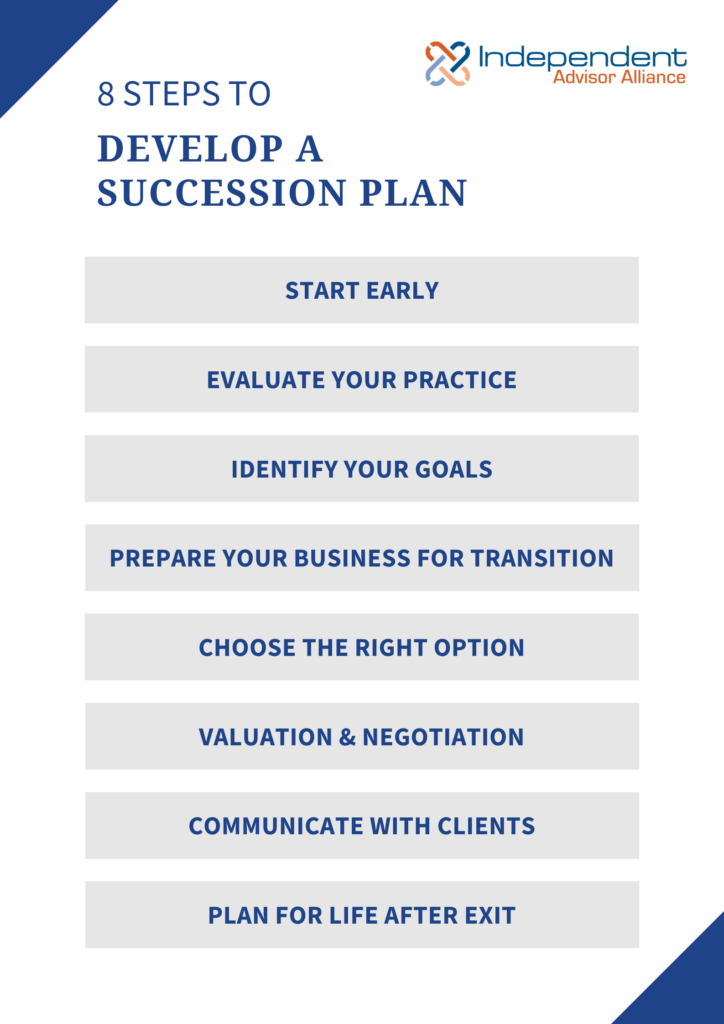As a financial advisor, you spend your career helping clients navigate the complexities of financial planning, investments, and wealth management. Yet, one critical aspect of financial planning often overlooked by advisors themselves is their own succession plan. Whether you’re considering retirement, selling your practice, or transitioning to a new career, a well-crafted plan is essential. Here’s a comprehensive guide to help you plan your succession effectively and ensure a smooth transition for you and your clients.
Understanding the Importance of a Succession Plan
A succession plan is not just about leaving your business; it’s about maximizing the value of what you’ve built and ensuring continuity for your clients and staff. A thoughtful succession plan addresses several key areas:
1. Financial Security
Ensures you reap the financial benefits of your hard work.
2. Client Continuity
Maintains the trust and satisfaction of your clients through a seamless transition.
3. Business Legacy
Preserves the integrity and reputation of your practice.
4. Personal Fulfillment
Allows you to exit on your own terms, ready for the next chapter of your life.
Steps to Develop a Succession Plan
1. Start Early
The earlier you start planning your exit, the better. Ideally, you should begin considering your succession plan at least 5-10 years before you plan to leave. Early planning gives you ample time to increase the value of your business, identify potential successors, and prepare your clients for the transition.
2. Evaluate Your Practice
Assess the current state of your business. This includes understanding its market value, strengths, weaknesses, and growth potential. A thorough evaluation will help you identify areas for improvement and make your practice more attractive to potential buyers or successors.

3. Identify Your Goals
What do you want to achieve with your exit? Consider both your financial goals and personal aspirations. Do you want a lump-sum payment, or are you looking for ongoing income? Do you want to remain involved in the business in some capacity, or are you looking for a complete break? Clear goals will guide your strategy.
4. Prepare Your Business for Transition
A business that runs smoothly without your constant involvement is more attractive to buyers. Develop systems and processes that ensure operational efficiency. This includes:
- Documenting Procedures: Standardize and document all business processes.
- Delegating Responsibilities: Empower your team to handle more responsibilities.
- Client Relationships: Foster strong relationships between your clients and your team members.
5. Choose the Right Option
There are several options to consider:
- Selling to an External Buyer: Often the most lucrative option but requires finding the right buyer.
- Internal Succession: Selling to a partner, employee, or family member can ensure continuity and preserve the business culture.
- Mergers and Acquisitions: Merging with another firm can provide growth opportunities for both parties.
- Gradual Transition: Gradually reduce your involvement while mentoring your successor.
6. Valuation and Negotiation
Get a professional valuation of your business to understand its worth. This will be crucial during negotiations. Work with financial advisors, accountants, and attorneys who specialize in business transitions to ensure you get the best deal.
7. Communicate with Clients
Transparency is key. Inform your clients about your plans well in advance. Reassure them that their financial interests will remain a priority and introduce them to their new advisor if applicable. Maintaining client trust during the transition is vital.
8. Plan for Life After Exit
Your exit strategy should include a plan for your personal life post-exit. Whether it’s retirement, pursuing a new venture, or spending more time with family, having a clear vision for your future will make the transition smoother.
Conclusion
Planning your succession strategy is a complex but essential part of your career as a financial advisor. By starting early, setting clear goals, and preparing your business and clients for the transition, you can ensure a successful and satisfying exit. Remember, the legacy you leave behind is not just in the numbers, but in the trust and relationships you’ve built over the years.
Taking these steps will help you exit on your own terms, ensuring financial security, client satisfaction, and personal fulfillment.
Download our Succession Planning Checklist to keep track of the questions you should consider when succession planning.

